
1-10 #NoNoNo : TSMC’s Arizona factory has reportedly picked up a second Apple product; Apple’s first foldable iPhone is allegedly to be released in 2026; Samsung Display has showcased its slidable displays; etc.

Taiwan Semiconductor Manufacturing Company (TSMC) is stepping up its efforts to expand its CoWoS (Chip on Wafer on Substrate) advanced packaging capacity with plans to double its monthly capacity to 75,000 wafers by 2025. This ambitious objective comes amid heightened demand for high-performance chips, powered by key clients like Nvidia. TSMC’s strategy includes repurposing the facilities acquired from Innolux to establish Advanced Packaging Fab 8 (AP8), dedicated to this production. In addition to building its own capacity, TSMC is collaborating with packaging partners such as ASE Technology and Amkor to collectively reach the 75,000 wafers per month target by 2025. The CoWoS technology, a 2.5D advanced packaging solution from TSMC, is designed for high-performance computing chips, including Nvidia’s H100 and B100 GPUs. By stacking multiple chips and memory, CoWoS enhances overall performance. TSMC currently employs CoWoS-S, CoWoS-L, and CoWoS-R configurations, with plans to move towards larger mask dimensions supporting more HBM memory in the coming years, propelling further advancements in packaging technology. (CN Beta, AInvest, TweakTown, TechNews)
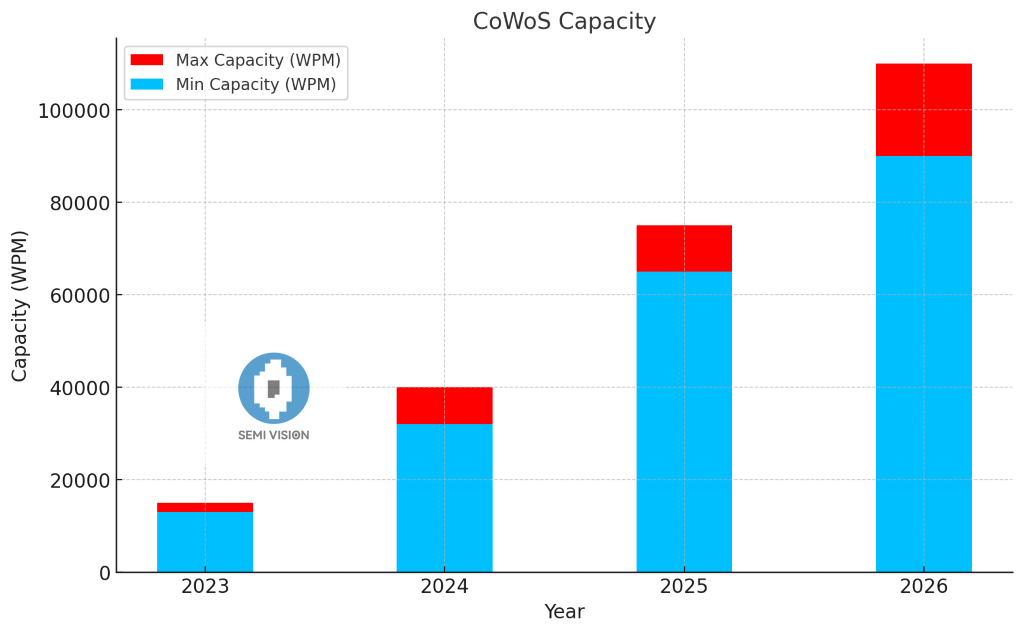
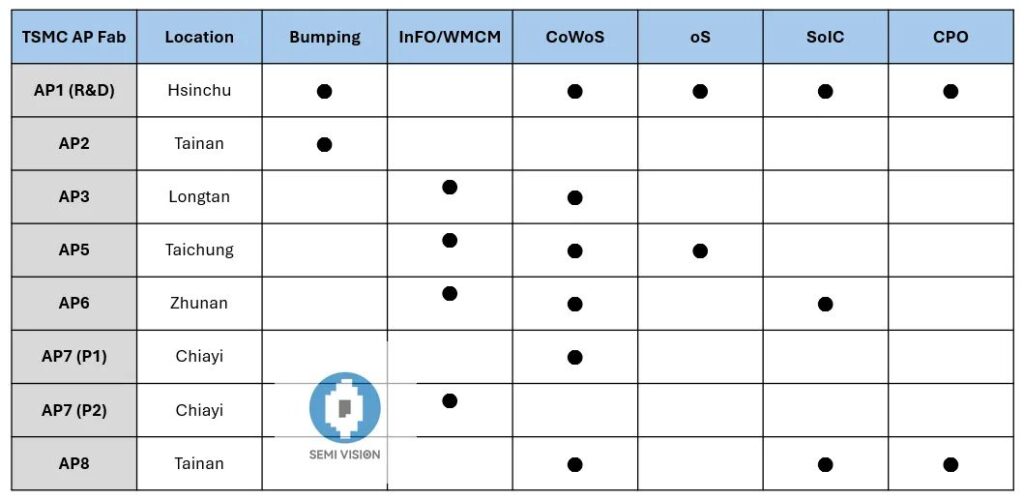
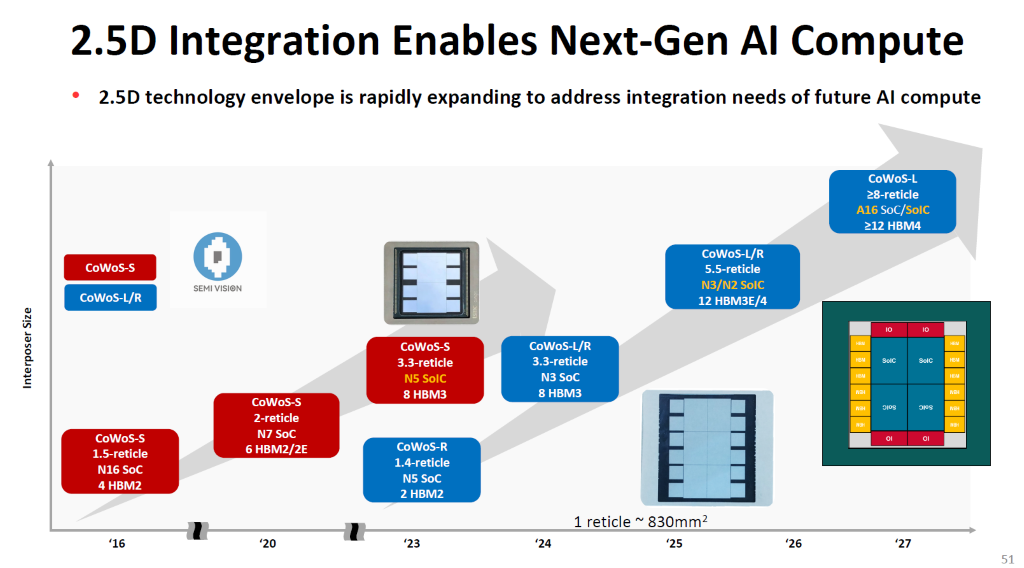
TSMC’s Arizona factory has reportedly picked up a second Apple product. In addition to the A16 processor for iPhones, the fab is now producing SiPs (Systems-in-Package) for the Apple Watch. This product is believed to be the S9 SiP. Recall that TSMC Arizona is manufacturing at N4 (part of the N5-family of process nodes) while the S9 is made in Taiwan at N4 and is a derivation of the A16, so this would make sense. Apple is not the only client having chips made at the Arizona facility. AMD is producing the Ryzen 9000 at the plant, a product AMD released in 2024. (CN Beta, Tom’s Hardware, Patently Apple, Apple Insider, Culpium)
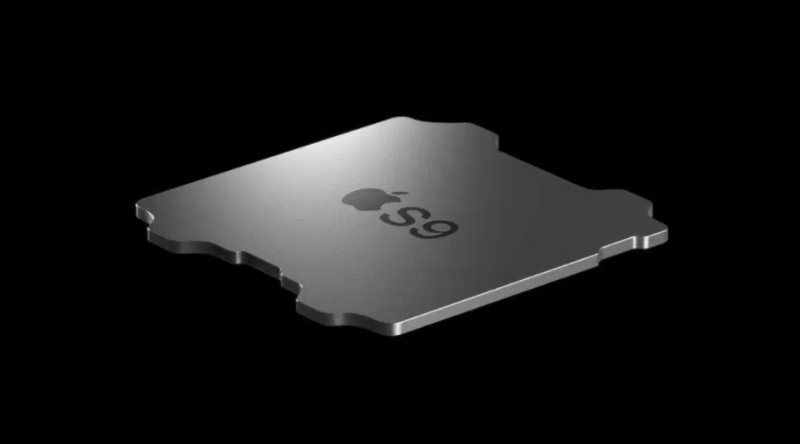
Qualcomm has unveiled Snapdragon X, the latest chip in its Snapdragon X Series of PC processors. The company claims that the chip, built on a 4nm fabrication process, delivers up to “multi-day” battery life and robust performance at an affordable price point. The company said Snapdragon X will power a range of Copilot+ PCs, Microsoft’s Windows 11 machines with AI-powered tools and applications, set to launch in 1Q25 and priced at around USD600. Packing Qualcomm’s Oryon CPU with eight cores clocked up to 3GHz, Snapdragon X also has a neural processing unit (NPU), which supposedly accelerates AI workloads. Other highlights include Bluetooth 5.4 compatibility, support for Wi-Fi 7, and the ability to power up to three external UHD (4K) monitors running at 60Hz. PC manufacturers that adopt Qualcomm’s Snapdragon X Platform, a new hardware reference program, will also get additional tech such as Qualcomm’s A/V suite and proprietary image processing.(The Verge, TechRadar, TechCrunch)
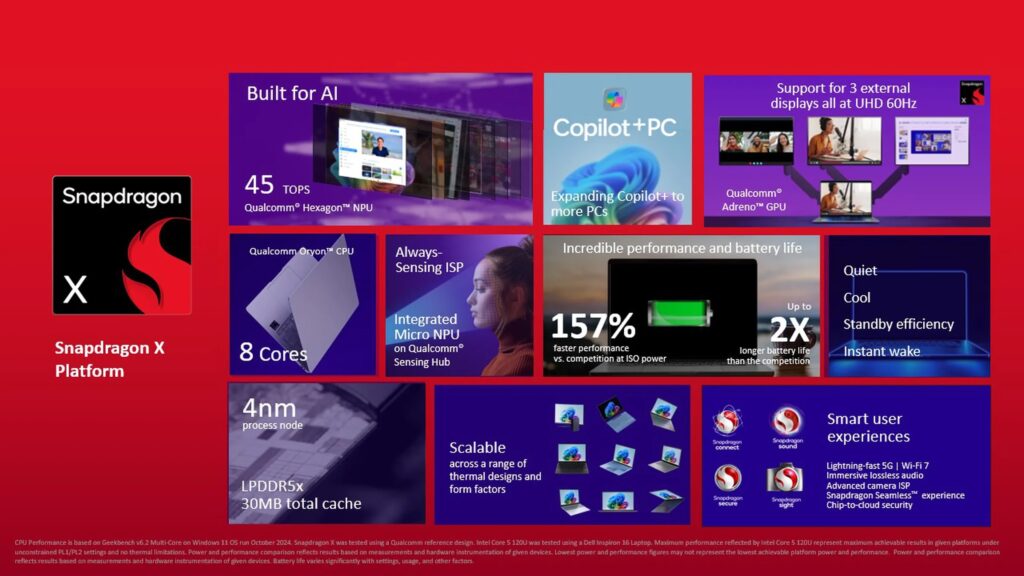
Nvidia has unveiled its newest “AI supercomputer”, called “Project DIGITS”, which is said to be the world’s most compact device to offer computational power that was previously deemed impossible. The Project DIGITS AI system comes with a new and unique GB10 Grace Blackwell Superchip. The chip utilizes NVIDIA’s Blackwell GPU, one petaFLOPS FP4 AI compute power, and an ARM-based Grace CPU, which features a 20-core configuration. The DIGITS supercomputer is equipped with 128 GB low-power DDR5X memory, along with a 4TB SSD for storage. All the components are interlinked through NVIDIA’s C2C interconnect, which allows NVIDIA to leverage architectural capabilities to bring in tremendous power. The DIGITS system is said to run up to 200-billion-parameter large language models, and by using NVIDIA’s ConnectX networking, linking two of these systems allows us to run 405-billion-parameter models, which is fascinating.(CN Beta, Nvidia, WCCFTech, Yahoo)
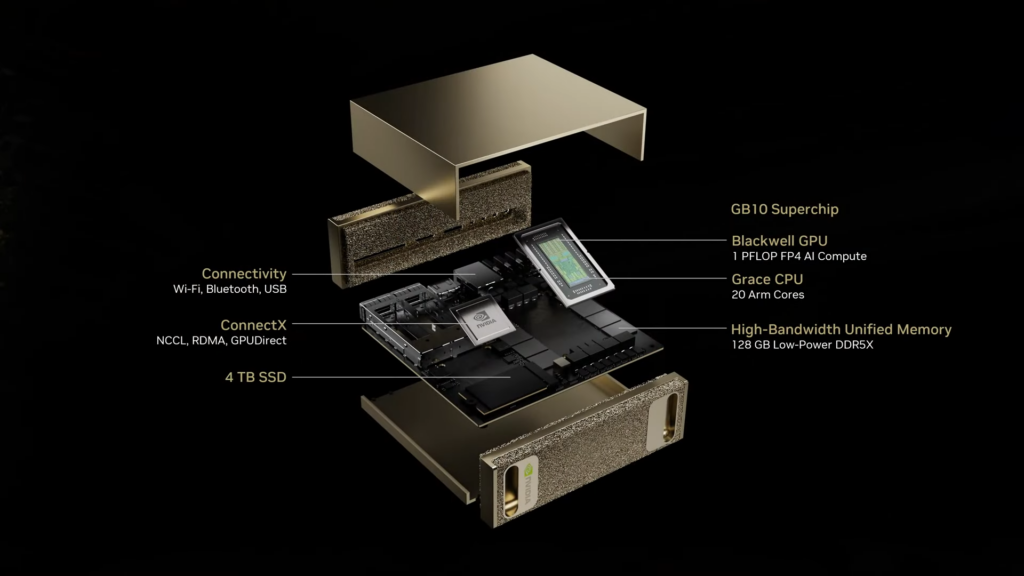
Intel has announced that its Panther Lake processor, the first to utilize the Intel 18A process node, will debut in 2H25. Intel’s Panther Lake is an essential processor for Intel as it will be 70% manufactured in-house, which means significantly lower costs and substantially higher profit margins. Panther Lake is reportedly the Core Ultra 300. The processor is reported to feature over 16 cores, with a mix of Cougar Cove P-cores and Skymont / Darkmont E-cores, and may include up to 12 Xe3 (Celestial) integrated GPU cores, based on architectural analysis. The 18A process is Intel’s first (or technically second, as the 20A process has been canceled) to feature RibbonFET gate-all-around transistors and the PowerVia backside power delivery network.(CN Beta, Tom’s Hardware, TrendForce, TechNews)


Samsung is rumored to apply Color Filter on Encapsulation (CoE) technology to the display of its Galaxy S26 Ultra, due to launch in 2026. CoE has been used in Samsung’s Galaxy Fold line since the Z Fold 3. CoE is a technology that replaces polarizing plates in existing organic light-emitting diodes (OLEDs) with color filters and changes the general PDL (Pixel Define Layer) to a black PDL. CoE replaces polarizers with color filters, thus improving light transmittance and making the OLED panel thinner in the process. Samsung has also changed the general Pixel Define Layer (PDL) to a black PDL, which reduces the light that’s reflecting inside the panel. (Android Central, The Elec, GSM Arena)
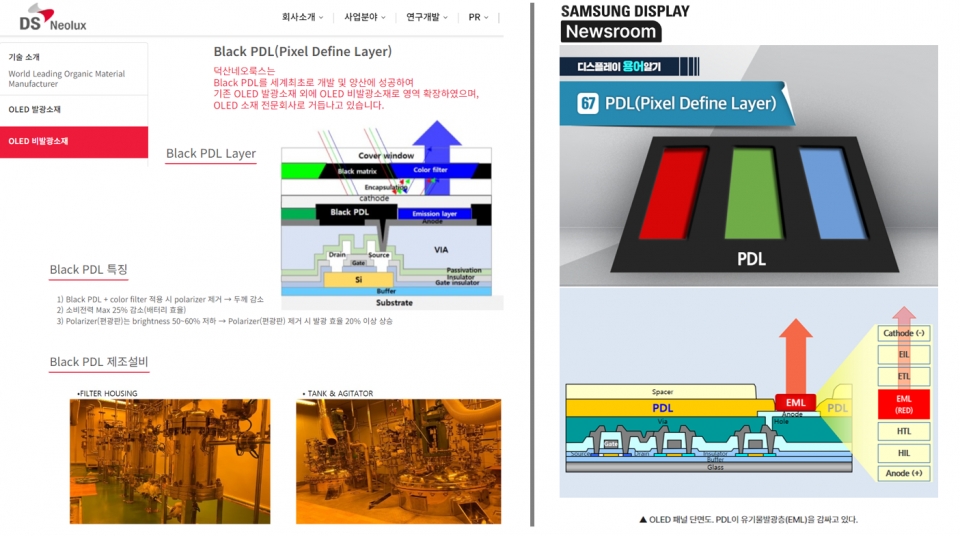
Apple’s first foldable iPhone is allegedly to be released in 2026. The first foldable iPhone will have an inward folding display. Its display will reportedly measure at least 7” diagonally. Apple is also working on a larger device intended to be used as a laptop. That device reportedly features a screen that unfolds into a 19” display. This device was initially planned to be released first, but Apple is now favoring launching the foldable iPhone first. (WSJ, Live Mint, Yahoo)
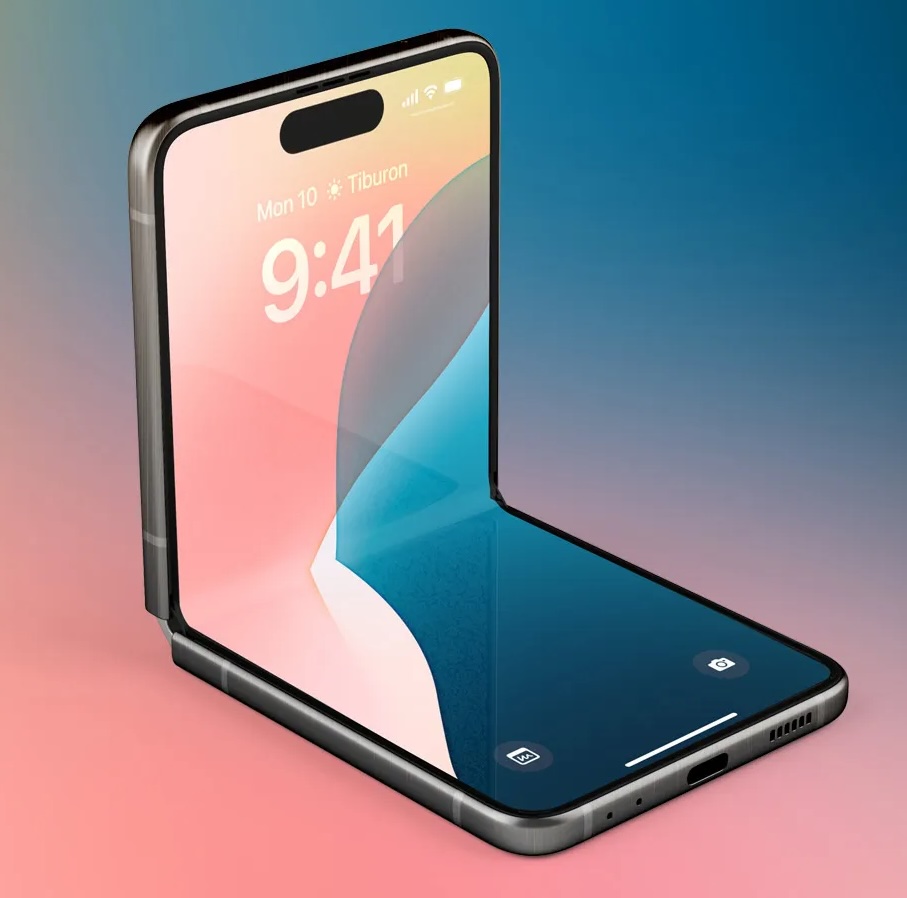
According to Meritz Securities, Apple’s first foldable iPhone will have a main display that measures 7.6”-7.9”, and a outer display 5.3”-5.5”. The displays for the first-generation product will be entirely supplied by Samsung Display. Starting in 2028, BOE, which has extensive experience in mass-producing foldable smartphones, is expected to join the supply chain. As for LG Display, it is reportedly working on large foldable products for Apple (estimated to be an 18.8” iPad). However, the release timeline is being delayed due to the lackluster performance of OLED-equipped iPads and their high price point. As a result, initial production volumes are expected to be limited. (TechRadar, Twitter, Phone Arena)
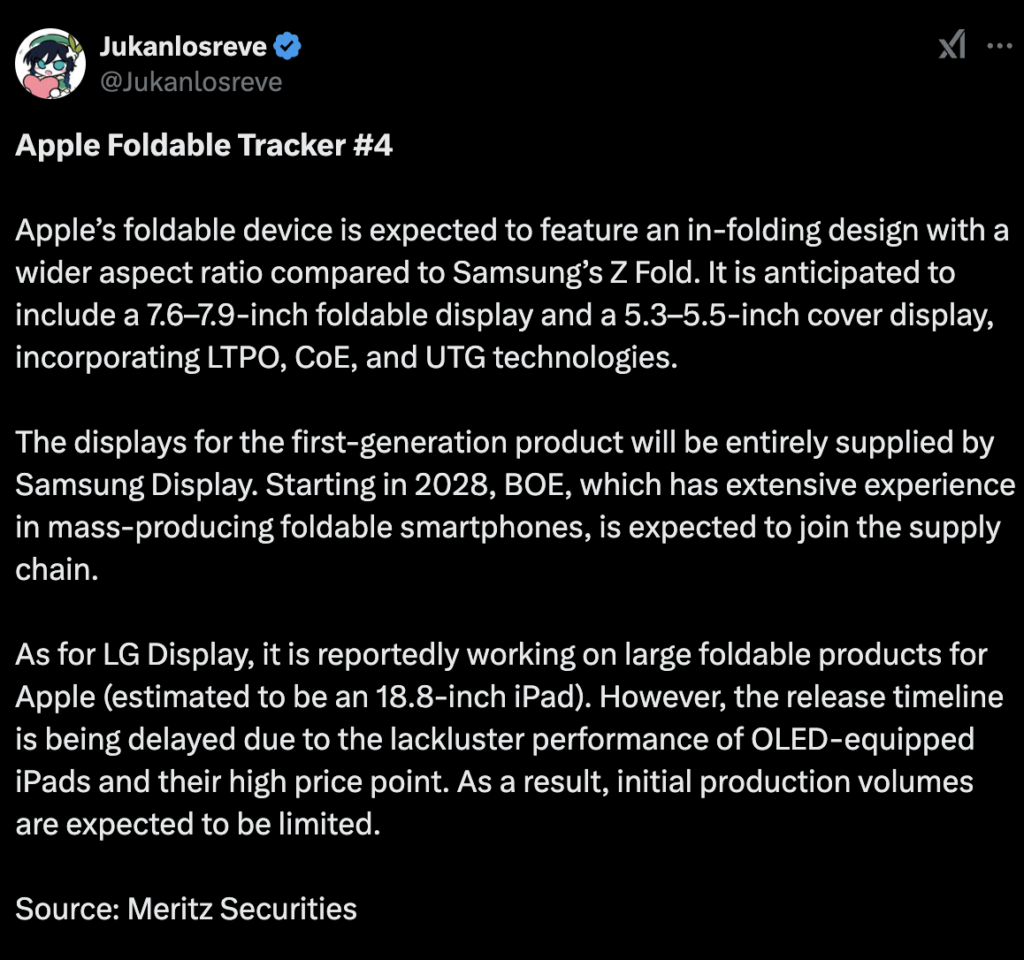
Samsung Display has unveiled its newer generation QD-OLED panel for TVs. The fourth-generation QD-OLED TV panels from Samsung Display can reach over 4,000 nits of peak brightness. The company says it achieved this feat using “an advanced panel driving technology and new organic materials”. Samsung Display has also announced its new-generation QD-OLED monitor panels. The panels will be available in 27”, 31.5”, 34”, and 49” sizes.(Android Headlines, TechRadar, SamMobile, Samsung Display)
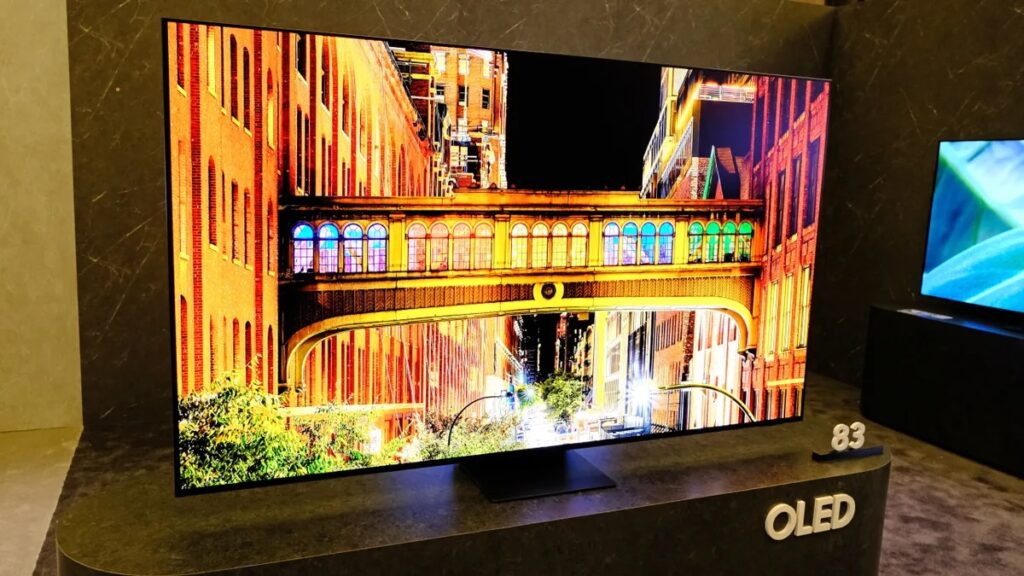
Samsung Display has showcased its slidable displays. The slidable display has 3 form factors: Slidable Flex Duet with a base size of 8.1” that can be extended up to 12.4”; Slidable Flex Solo that starts at 13” and grows up to 17.3”; and Slidable Flex Vertical is aimed at devices that usually use vertically—mainly smartphones, which has a fairly compact base size of 5.1” that can grow up to 6.7”. (Android Headlines, Gizmo China, Samsung Display)

Technology company Smartkem has a solution to the high manufacturing costs involved with microLED displays and is working with display maker AUO on a transparent, rollable microLED that, although modestly sized now, could be the start of something much bigger. Smartkem’s manufacturing process enables the microLEDs to be connected and tested prior to completion, increasing the yield. The process is the result of 15 years of research into organic transistors and an USD80M investment. Smartkem worked with the Industrial Technology Research Institute (ITRI) in Taiwan on a prototype production line making transistor sheets for tablet-sized displays. Subsequently, optoelectronics company AUO in Taiwan approached Smartkem to use its technology to make a 12.7”, tablet-sized, flexible, transparent screen together. (Digital Trends, Yahoo)
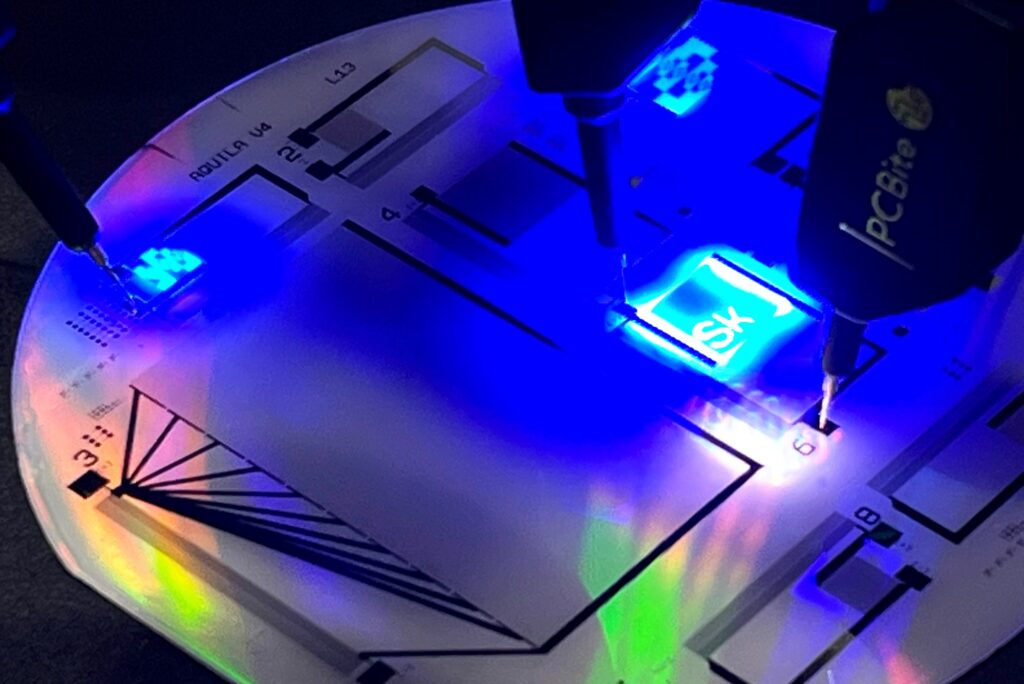

Micron Technology is set to invest SGD9.6B (USD7B) in Singapore over several years to meet the rising demand for advanced memory chips driven by artificial intelligence (AI). The US semiconductor company has commenced construction on a new high-bandwidth memory (HBM) advanced packaging facility next to its existing Singapore operations. The facility is scheduled to come online in 2026, with significant expansion of Micron’s total advanced packaging capacity expected in 2027 to meet AI growth demands. The company’s future expansion plans in Singapore will also support long-term manufacturing requirements for NAND chips. Micron said it plans to maintain flexibility in managing capacity ramp-ups in both HBM and NAND facilities to align with market demand. (CN Beta, Mobile World Live, Forbes, Yahoo)
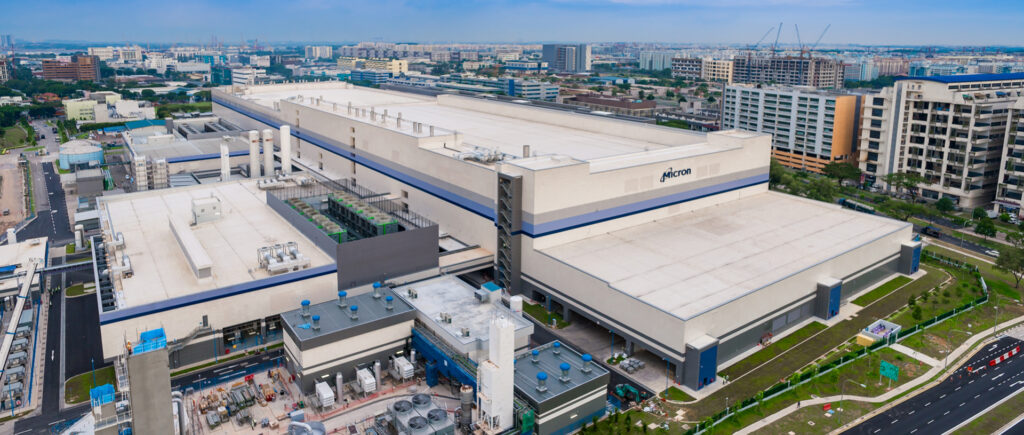

Tecno has showcased its latest concept development with its Starry Optical Fiber technology. This is a mixture of optical fibers and mini-LED lights placed inside the battery cover of a modified Phantom V Flip 2 for a one-of-a-kind shimmering look. Tecno says the Starry Optical Fiber process involves 30 manufacturing processes and features 150 ultra-thin optical fibers combined with 108 mini-LED lights, which were carefully threaded via UV adhesive to form a fabric-like structure.(Android Headlines, GSM Arena)
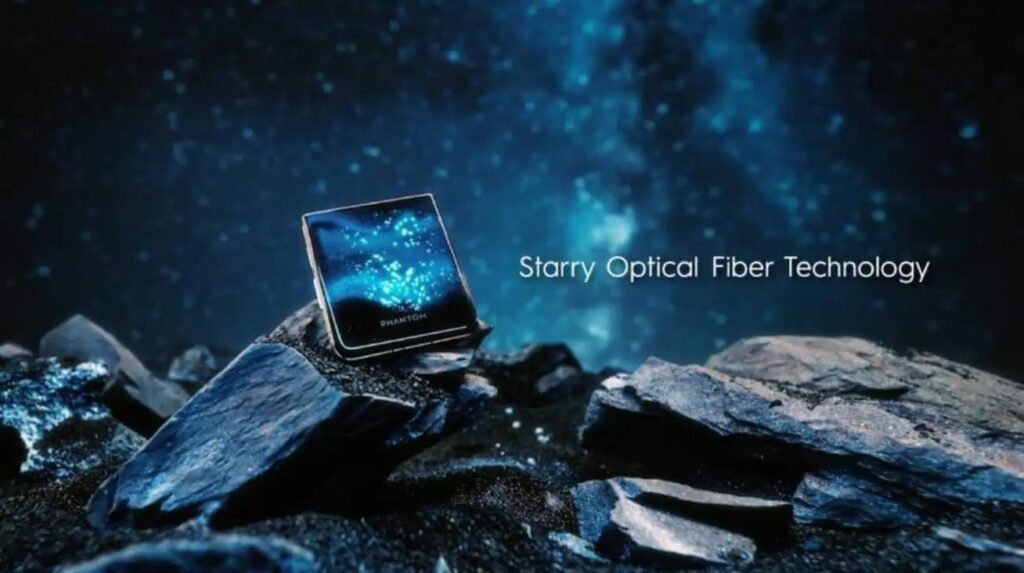

JEDEC Solid State Technology Association, the global leader in the development of standards for the microelectronics industry, has announced the publication of JESD220G: Universal Flash Storage 4.1. In addition, an update to the complementary JESD223F UFS Host Controller Interface (UFSHCI) version 4.1 standard has also been published. Developed for mobile applications and computing systems requiring high performance with low power consumption, UFS 4.1 offers faster data access and improved performance over the earlier version of the standard while maintaining hardware compatibility to UFS 4.0.(CN Beta, JEDEC, Yahoo)

Apple’s suppliers Foxconn Technology Group and Dixon Technologies India are asking India to pay them billions of rupees in subsidies they think they are entitled to under the government’s production incentives program. The government pledged a total of INR410B (USD4.8B) in subsidies to manufacturers, and part of that remains unallocated because some companies didn’t meet estimated production targets. Foxconn and Dixon argue that, according to the program rules, they are eligible for some of the unallocated funds. Foxconn could get as much as INR6B and Dixon INR1B if the government releases the funds. Foxconn’s roughly INR300B of iPhone production in the fiscal year through Mar 2023 exceeded its cap of INR200B. And Dixon’s production of INR80B in the fiscal year through Mar 2024 surpassed its cap of INR60B. (CN Beta, Apple Insider, Bloomberg, Yahoo)
Apple still cannot sell its iPhone 16 in Indonesia despite striking a deal to build a local production facility there, as it has not met domestic content rules. In 2024, Indonesia banned iPhone 16 sales after Apple failed to meet requirements that smartphones sold domestically should comprise at least 35% locally-made parts. Minister Agus Gumiwang Kartasasmita said Apple had struck a deal to build a facility producing its Airtag tracking device on Indonesia’s Batam island, close to Singapore, but that still would not count as a locally-made iPhone part. Indonesia’s investment minister said that the factory would be worth USD1B and that it would start operations in 2026. (GSM Arena, Reuters, CN Beta)

Dell is simplifying its branding. The new lineup will consist of three main categories: Dell for everyday use, including school and work; Dell Pro for professional-grade productivity; and, Dell Pro Max for maximum performance. Within each category, products will be further divided into Base, Plus, and Premium tiers. The company CEO Jeff Clarke stated that customers prefer names that are easy to remember and pronounce. The company says the decision is supported by research involving “tens of thousands of customers”. The new naming system will be gradually implemented, but current products with old names will continue to be sold until discontinued.(Liliputing, Yahoo, Dell)
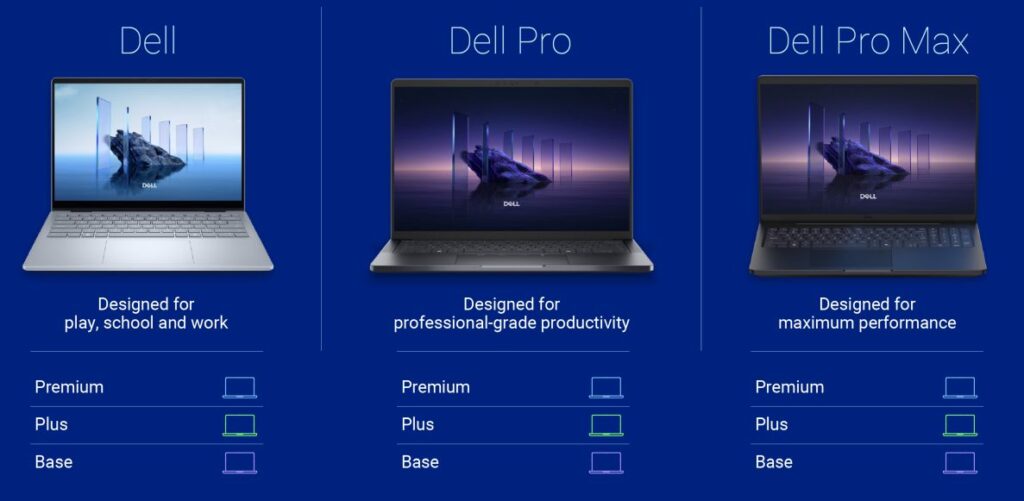

Apple has announced that Apple Fitness+ is set to gain new workout programs, breath meditation, Strava integration, and more. Strava users will be able to share a Fitness+ workout directly to the Strava app, which will display rich details such as episode image and number, trainer name, and metrics to show to their Strava community. Celebrated Strava athletes will also join the Fitness+ trainer team as special guests in workouts throughout 2025. New and existing Strava subscribers can now redeem up to three months of Fitness+ at no additional cost. An all-new progressive strength training program will help guide users through the process of building and maintaining strength. (MacRumors, Apple)


Google Home is testing expanded presence sensing support for more smart home devices. The feature can now consider the media playback statuses of other devices, like game consoles or smart displays. Beginning as part of the Google Home app public preview, presence sensing can take into account the status of smart home devices to detect whether you’re home or away. Google says the following types of smart home devices can be used for this presence sensing test: Smart speakers and displays, TVs (including Google streaming devices), Game consoles and streaming sticks and boxes. These data points, while not foolproof, can help Google Home figure out if anyone is home or if everyone is away. (Android Central, 9to5Google,Google)
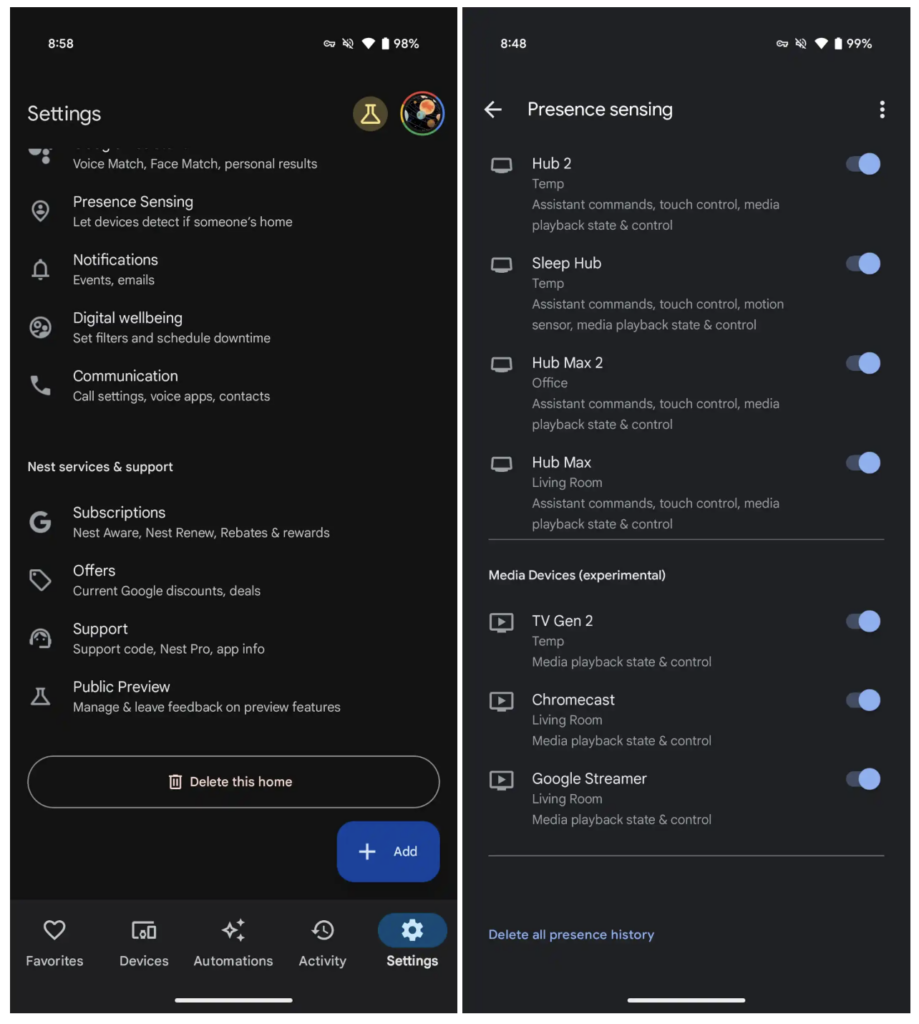

Samsung’s vice chairman, Han Jong-hee, has announced that the company will begin a phone subscription service under its “AI Subscription Club”. This service pertains to South Korean residents only as Samsung has said whether the U.S. or other markets will see the Club or the phone plan. As Samsung Electronics is applying a subscription model that combines maintenance services beyond existing installment sales for mobile devices such as smartphones and tablets, attention is being paid to how the distribution paradigm for mobile devices such as smartphones will change in the future. In particular, as consumers who have felt the burden of purchasing self-funded phones have tended to purchase them using card instalments on online malls, it is expected to have a positive effect on improving the sales performance of mobile devices at Samsung Store. (ET News, Android Central)
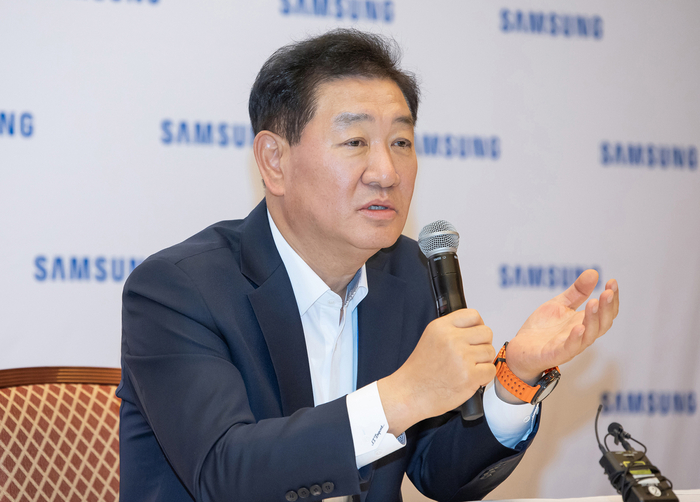

RoboForce, with the ambition of creating hyper-accurate robot workers to do tasks like solar panel installation, has announced USD10M in early-stage funding. With this funding, RoboForce is emerging from stealth as it prepares to deploy its Robo-Labor this year for early customers, for whom robots can fulfill labor shortages in harsh outdoor conditions, complete the most hazardous tasks in dangerous work environments, and maximize project efficiency and cost savings. With 1mm accuracy in performing fine motor skills like picking, placing, pressing, twisting and connecting, the Robo-Labor has all-terrain mobility, precise manipulation, learning, communication, and safety compliance capabilities. RoboForce will launch one to two pilot solar projects with its robots in 2025. (TechCrunch, Yahoo)
